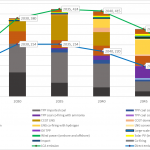Khanh Duc Hoang – School of Electrical Engineering, University of Ulsan, Ulsan, Korea. E-mail: duckhanhht13989@gmail.com
Dong-Choon Lee – Department of Electrical Engineering, Yeungnam University, Gyeongsan, Korea. E-mail: dclee@yu.ac.kr
Hong-Hee Lee – School of Electrical Engineering, University of Ulsan, Ulsan, Korea. E-mail: hhlee@mail.ulsan.ac.kr
Abstract
In this paper, a control strategy is proposed for both accurate current sharing among distributed generators (DGs) and the point of common coupling (PCC) voltage restoration in low voltage direct current (LVDC) microgrid by injecting a small AC signal to the output voltage of the DG. The small AC signal frequency changes proportionally to the per unit (pu) output current of the corresponding DG, and the DG output voltage is regulated to share every DG with the equivalent frequency in the steady state. Especially, for easy implementation, the reactive power of the AC signal is controlled to indirectly regulate the AC signal frequency. Moreover, the equivalent pu output current is used to determine the voltage shift-up in order to restore the PCC voltage. Because the proposed control scheme is developed with the fully distributed manner at local controller for each DG, it can be implemented economically without external communication network. The effectiveness of the proposed control method is proved by the simulation. Index Terms—DC microgrid, droop control, current sharing, voltage improvement.
I. INTRODUCTION
With the substantial penetration of the renewable energy source that has a dc output power (e.g., photovoltaics (PVs), fuel cells) into power system and the growing of DC load applications, DC microgrid has been attracting many interests. The main motivations to develop DC microgrid are its highly efficient energy conversion and simple control scheme [1]–[3]. In order to effectively manage power systems in DC microgrids, it is important to ensure the stable operation and cooperation of different types of energy sources.
In [4] and [5], the master-slave control methods were presented to cooperate among the distributed generators (DGs) in DC microgrids where a high bandwidth communication were used to share the information among the DGs. However, these approaches raise the risk of the single point failure which damages the system operation. Another approach is the voltage droop control to properly control the load sharing among the DGs [6], [7]. In this approach, the line resistances are neglected to make the output voltages stable. However, the accurate current sharing is deteriorated due to the actual line resistances. In addition, the voltage drop due to the inherent characteristic of voltage droop control reduces the voltage on the point of common coupling (PCC) in DC microgrid [8]. In order to improve the current sharing accuracy and the voltage regulation in DC microgrid, the secondary control layers relying on communication network were proposed [9]–[12]. However, the communication delay affects the stability and the reliability of the system especially when the sources are separated with long feeders [13].
With the attempt to be independent on the communication network, authors in [14] proposed “Power Talk” concept to communicate among the DGs. In this method, high frequency communication signal is modulated to the output power of the corresponding DG, and the electric lines are used as communication links. However, this approach leans on the states of the system such as the line resistance and the load condition which are unpredictable in practical application. Meanwhile, the frequency-based power sharing technique was firstly developed for AC power systems [15], and then, it was also applied to the DC microgrid [16]. However, the method are not suitable for the low voltage DC (LVDC) microgrids with the resistive line characteristics [17]. Based on the method proposed in [15] and [16], the frequency-based current sharing technique applied to LVDC microgrids was proposed in [17]–[19]. However, in [17] and [19], only accurate current sharing is achieved, while the PCC voltage drop is not considered. In [18], the PCC voltage restoration at distributed secondary layer was taken into account along with an accurate current sharing. Nonetheless, the control scheme is very complicated due to the secondary control was not decoupled with the primary control.
In this paper, we propose an accurate current sharing and the PCC voltage restoration in LVDC microgrid based on the frequency-based current sharing technique. In the proposed control method, a small AC signal with the frequency generated according to the per unit (pu) output current is injected to the output voltage of the corresponding DG. In the steady state, the accurate current sharing is achieved by regulating the injected AC signal frequency to be equivalent frequency. And also, the equivalent pu output current is used to restore the PCC voltage. Furthermore, the controller only uses the local information about the output voltages and current of DGs without external communication network, which enables the system economic and easy to implement. The proposed control method is analyzed theoretically, and its effectiveness is also verified by simulation.

Fig. 1. DC microgrid: a) Two source DC microgrid model, b) Equivalent circuit
Fig. 2. Proposed control scheme





